“We’ve got some issues here,” said Hector Hueso.
The outreach worker was pulling up outside the Wells Fargo on Highland Street in National City. It had rained last night, and raindrops still clung to the windows of the truck. It was a little after 8 a.m. and the outreach team was just getting started with their day when they spotted a tent set up under the bank’s awning.
That was worrying Hueso because the tent was on private property. They were going to have to tell the owner to move.
“Look at that,” he said. “Right in front of the bank. That’s not good.”
“Oh, wait!” said Qiana Williamson. The longtime caseworker — and the second half of the outreach team — was sitting in the passenger’s seat. She recognized the tent’s owner. The team had worked with him before.
“We can talk to him,” she said and stepped out of the truck.
For close to a year now, National City has been experimenting with a different way for the city to reach out to residents who are experiencing homelessness.
In most major cities, like San Diego and Chula Vista, that task falls to the police. There are many nonprofit and other agencies that reach out to unhoused people separately. But when it comes to actual city employees, officers are usually the ones unhoused residents come face-to-face with.
In National City, it’s two caseworkers who show up: Hueso and Williamson. Last year, the city created its first outreach team staffed solely by trained caseworkers who have experience with unsheltered communities and trauma-informed training. They called it the Homeless Outreach and Mobile Engagement, or HOME, team.
As leaders across the West Coast have taken a harsher stance on things like encampments, National City is one of the few cities that have moved away from criminalization. It’s an approach city officials, outreach workers, advocates and researchers said is a step in the right direction.
Almost a year into the program, city officials say it’s showing signs of working.

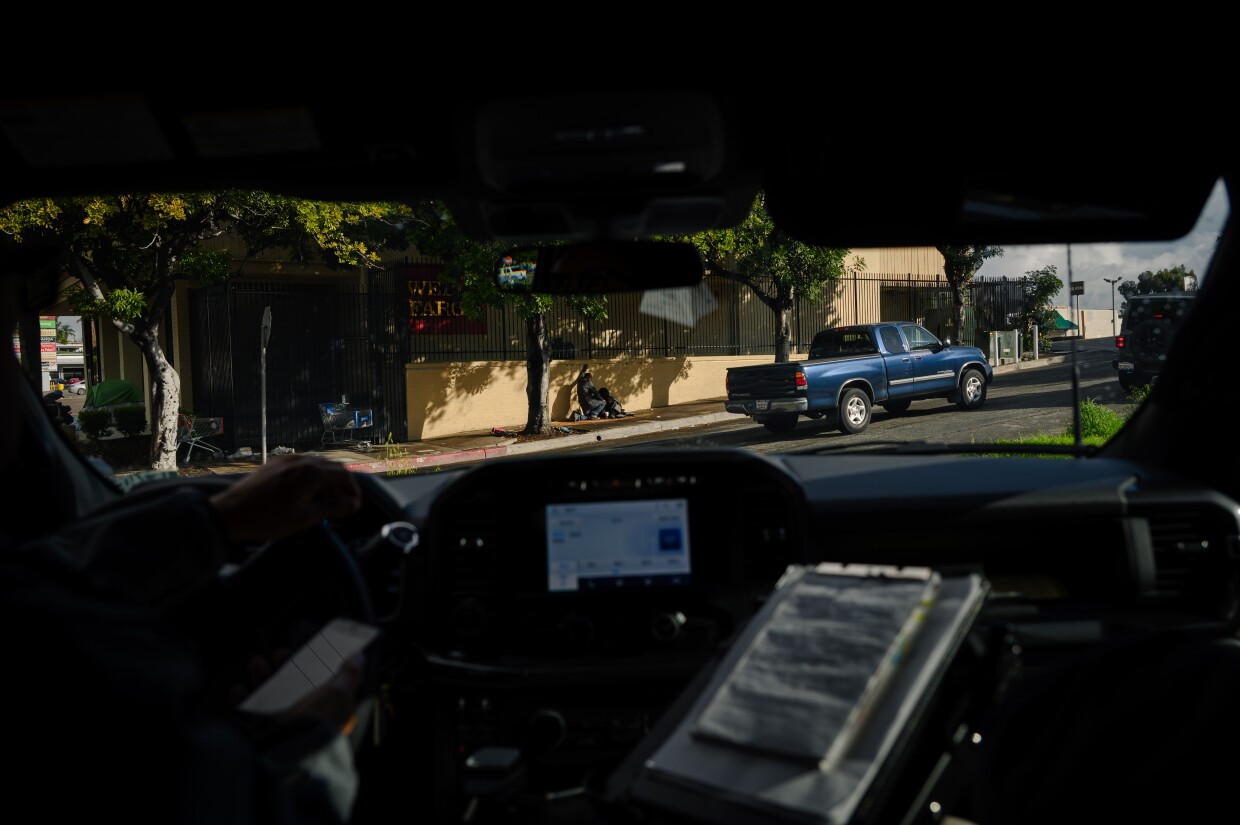
But the city is also facing new challenges as National City’s larger neighbors have pushed for a harsher approach to homelessness. Last year, San Diego adopted a sweeping ban on encampments, and Chula Vista is now weighing a ban of its own.
Those decisions have put greater pressure on city leaders to also take a harder line on homelessness too — a decision some experts say could undermine the work the city’s HOME team has been doing.
Back on Highland Avenue, Alien Gonzalez, the man with the tent, watched the two city outreach workers pull up in their white truck.
Gonzalez had been experiencing homelessness in the San Diego area for decades. That night, he had set up his tent beneath the awning of the Wells Fargo to keep some of the drizzle away. Now, as the city workers parked across the street, he got ready to pack it up.
In another city, this interaction might have gone differently. But Gonzalez knew the two outreach workers. They had already been talking for several months now. As Williamson and Hueso got out of the truck, he crossed the street to meet them.
Even though they were there to tell him that he had to move his tent, Gonzalez was happy to see them. The outreach workers had helped him schedule appointments with Medi-Cal and buy a sturdier tent and a camping stove to heat up coffee on cold days, he said. Since he met them, he felt like his life had started to turn around.
“I feel proud for them,” he said. “For what they do.”
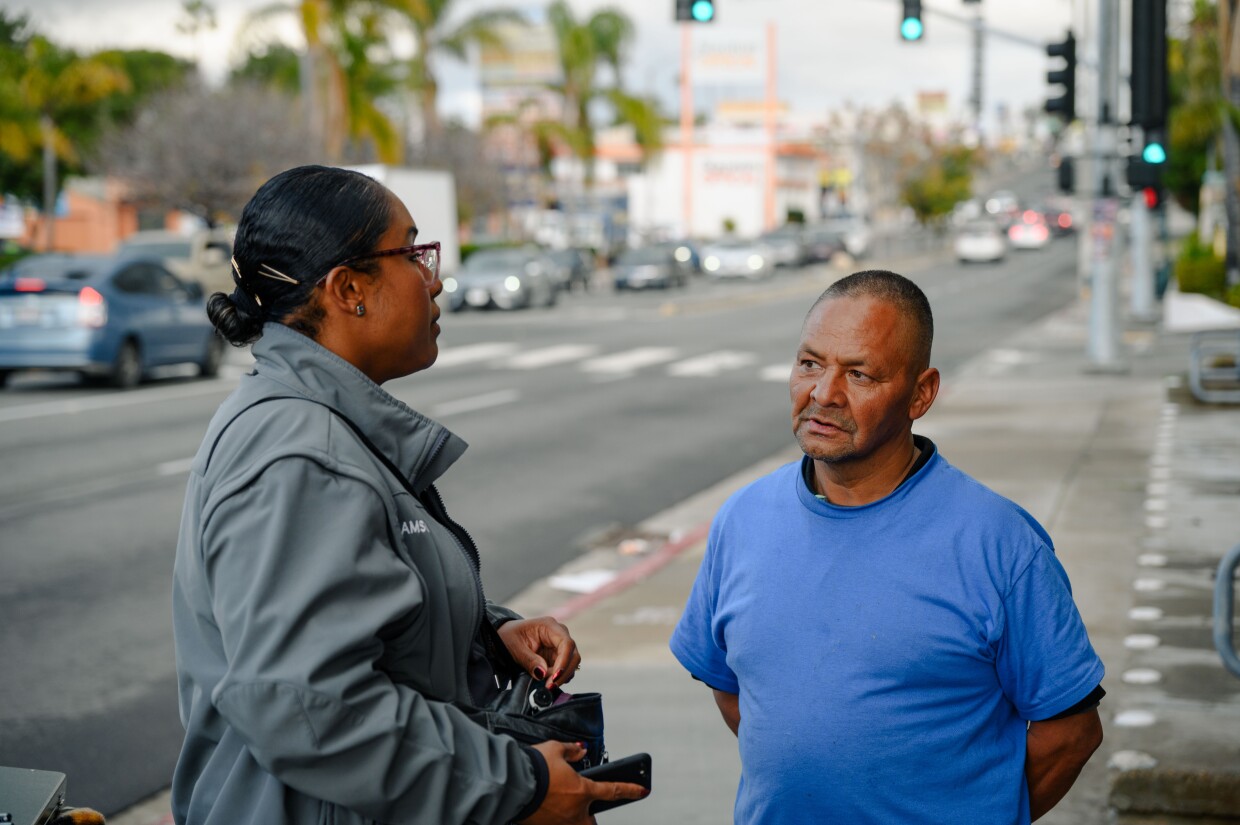
'Not case managers'
The system meant to support San Diego County’s growing unhoused community is a complicated network of services and organizations. There are shelters that pop up during extreme weather, hotlines that residents can reach out to for information, regional task forces and neighbors just trying to do what they can.
Outreach is a vital part of that patched-together safety net. These are the workers who regularly visit people living on the street and in encampments, trying to connect them with that complicated web of services. These teams proactively reach out to unsheltered communities instead of waiting for them to call an emergency hotline or walk into a shelter.

Government employees often play a very small role in outreach work. In many parts of the county, most of this work is done by nonprofit aid workers. Many of them do receive some taxpayer funding. The city of San Diego, for example, contracts with PATH, San Diego LGBT Community Center, and a handful of other organizations to run outreach teams.
But when it comes to actual city employees that go out and talk to people experiencing homelessness, that usually falls to the police department.
For years, that was how it worked in National City, too. The city’s police department had a designated officer who led outreach efforts and did his best to work with nonprofit organizations and county agencies.
Sometimes interactions between police and unhoused residents can be positive. Officers who’ve worked on outreach teams often share stories about seeing familiar faces on their beat and relationships they’ve built with people living on the street.
But many homelessness advocates and researchers argue that police-led outreach teams don’t have the training needed to approach and talk to people experiencing homelessness in a way that will make them feel comfortable — and more likely to trust and accept help.

Until last June, homelessness advocate Rachel Hayes was living in a tent on the street in downtown San Diego. She has few memories of officers doing anything but harassing her and her unhoused neighbors.
“I have tons of videotape of city workers throwing people’s entire lives away,” she said.
Because of that, Hayes and others say many unhoused people see police officers as more threatening than helpful and are less likely to be honest about things like how they lost housing and whether they are using drugs or experiencing mental health issues.
“We are increasingly relying on law enforcement, which is supposed to deal with criminal problems, to deal with social problems,” said Odilka Santiago, assistant professor of sociology at University of San Diego. “They're not adequately trained to necessarily provide trauma informed care.”
In some cases, these special teams place an additional burden on police departments — many of which have faced mass resignations and struggled to recruit new officers since a Minneapolis police officer murdered George Floyd four years ago.
The San Diego region has also done a poor job of coordinating and focusing its outreach efforts in past years. In 2020, a city of San Diego audit found that the county didn’t have a comprehensive strategy or enough regional coordination to drive “large-scale, systemic improvements.”
The result, critics say, is that police-led outreach teams can draw a lot of city dollars but do little to actually help people move off of the street.
"Police officers are not case managers," said National City City Manager Ben Martinez. "They just can't spend the time. It takes that time."

The La Mesa model
Over the last year though, National City has transformed its outreach efforts into something new.
On that morning earlier this month, Williamson and Hueso drove back and forth across the city. “Saturday Love” by Cherrelle and Alexander O'Neal played on their truck radio as the two outreach workers drove to visit small encampments under the freeway, stopped by tents and knocked on RV doors. When people weren’t there, they left their contact information tucked where it was easy to find. They spoke with working people living out of their vehicles, chronically unsheltered residents and people experiencing mental health issues.
Some they recognized. Some were new faces. For all of them, Williamson and Hueso had the same questions.
“I am going to ask, ‘How did this happen? What can we help you with?’” said Williamson. “I don't want to just provide hygiene kits. That's not outreach … Outreach is engaging an individual and holding hope for them.”
The city’s model is based on a team in La Mesa. In late 2020, the city launched its own HOME team of trained outreach workers, basing it on an Oregon program called CAHOOTS.
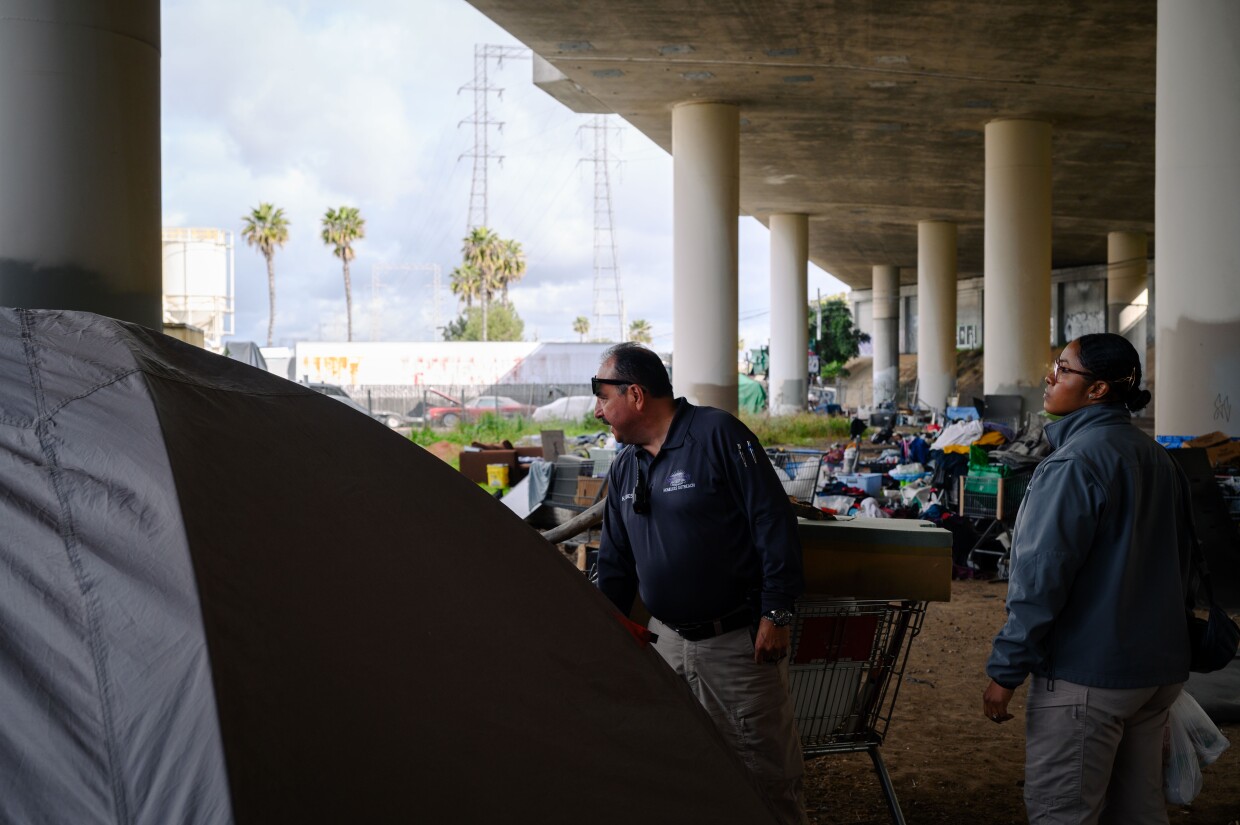


There are a few key things that make the HOME approach unique.
The first is having a vehicle — which is crucial, according to Matthew Smiley, an outreach worker in La Mesa. The La Mesa team has its van, and National City’s team has a big, four-seat pickup truck. That allows them to be constantly moving around the city and to give people rides.
Both teams also have a lot of freedom to do what they think is best. There are no quotas to meet. If Williamson and Hueso need to, they will spend an entire day with one person, they said — helping them get to the DMV to apply for a state ID, for example.
HOME teams are also entirely city-run, giving them stronger access to resources, support and direct connections to other city departments.
That also helps the team sidestep the issues of burnout and turnover that are common in outreach work, Smiley and Hueso said. In many cases, nonprofit outreach jobs don’t pay very well, leading more workers to leave for management roles or leave the field altogether. Cities, on the other hand, are often in a better position to support outreach workers with better pay and benefits.
La Mesa officials say they’ve had a lot of success so far. In the three years since it launched, the team has permanently housed 115 people. Unsheltered homelessness in La Mesa also fell by a third in the program’s first year, and it hasn’t gone back up.
“There are some hard cases of people that have been living on the street long before the HOME team ever existed ... that we've gotten housed and have stayed in,” said Smiley. “So I think we have had some really great successes with this program.”
National City hopes to follow in their footsteps.
City officials say they’re seeing early signs of success too. So far, the team has been able to help 16 people move into permanent homes.
“We don't have the answers yet,” said Ben Martinez, National City’s city manager. “But we are entering kind of a new era in providing services to the homeless.”
Homelessness researchers and advocates said the HOME model was a clear step in the right direction.
“I would say that it's the wisest investment they've made,” said Hayes, the recently housed advocate. “Not having the police involved and let their outreach team grow.”
“I think this is a wonderful approach,” said Stacey Livingstone, a postdoctoral fellow at UC San Diego’s Homelessness Hub, after reviewing the details of the program. “I am really happy to hear that it's trauma informed.”
For Williamson and Hueso, this job is also very personal in different ways.
Hueso, who spent years working with unhoused people and domestic violence survivors, grew up in Southeast San Diego and spent lots of time in National City, hanging out and going to the mall. Many of his family members still live in the city.
“I kind of feel like a keeper,” Hueso said. “I drive around their areas and make sure everything is good out there.”
Williamson started working in shelters because she and her mother grew up homeless and she saw how people were not willing to give her mother information about services.
“I realized, ‘hey, I can provide these services to other people,’” Williamson said. “Whatever their needs are, I can meet those needs.”
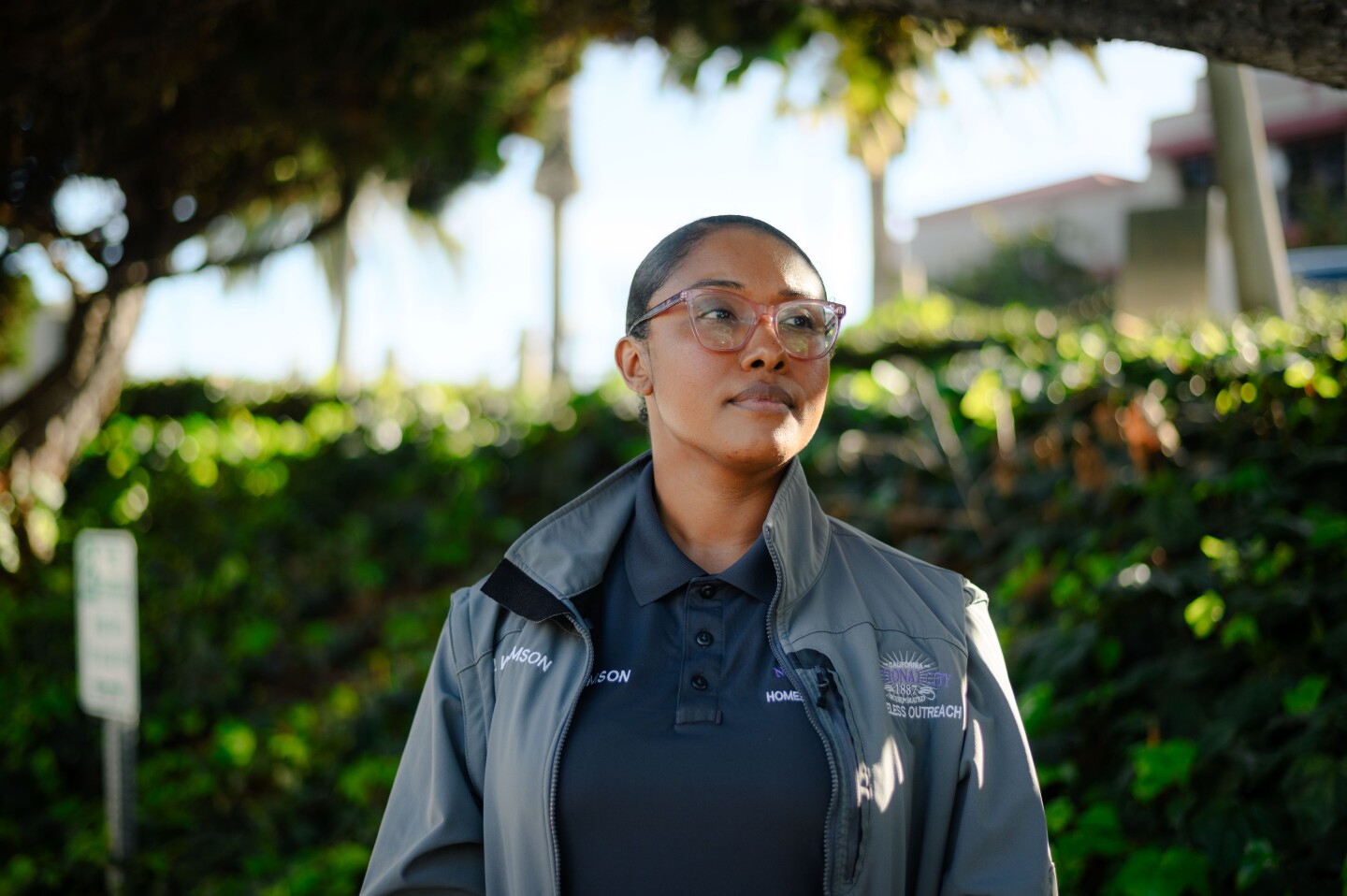
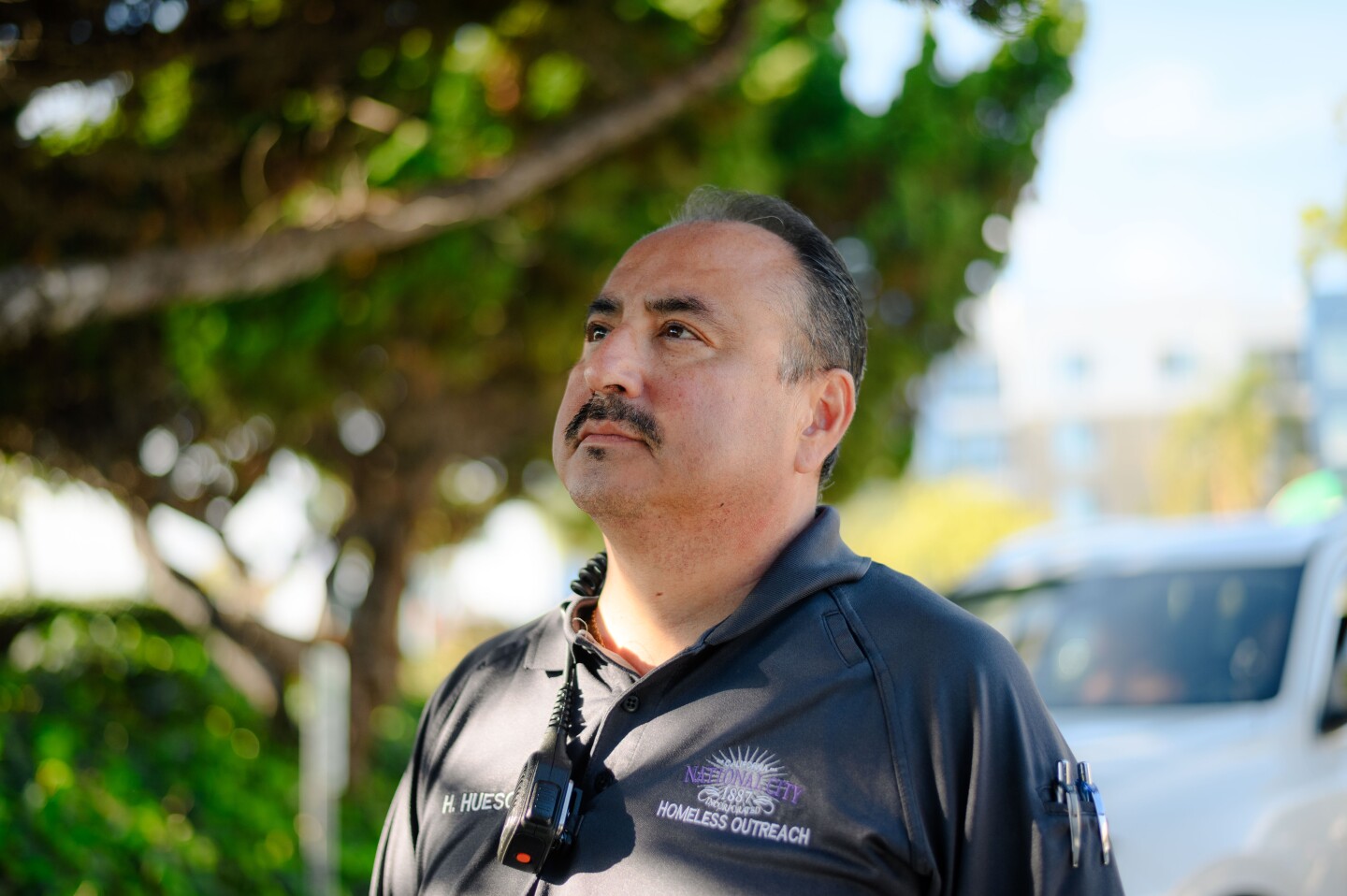
A crossroads for National City
Now though, National City is being pulled in different directions.
Like many cities throughout California, the South Bay city is still grappling with the chaos of the pandemic, which ended up pushing many people into poverty and more out of their homes. The winter floods that struck the San Diego area in January also hit National City hard, leaving many renters without a permanent home.

Officials also said they have been seeing more unhoused residents moving into National City from San Diego in the months since the county’s largest city made it illegal to set up tents on the street and on other public property. Other California cities, including neighboring Chula Vista, are also considering similar crackdowns on encampments.
Some of National City’s elected leaders said they’re now feeling more pressure to move back towards criminalization. The City Council has tasked staff with drafting a possible encampment law of their own, which could come before city leaders as soon as next month.
“We don't want to play the game of moving people around,” said Martinez, the city manager. “We recognize that moving people around does not help people get off the street. But I think at the end of the day, it's a very complex problem — and I think that complex problems require complex responses.”
It’s not clear yet how a ban would affect the city’s HOME team. Williamson and Hueso both said they didn’t think it would necessarily change their work significantly.
Still, an encampment ban in National City would be a change in direction for a city that has been moving away from criminalization. And some experts warned that it could undermine the work of the HOME team before the program has a chance to fully get off the ground.
“It's going to hurt the relationship that the outreach workers have made with these people because they're not going to be able to find them,” said Hayes. “It's going to add more trauma to people who already have a very traumatic life.”

Back in National City, Williamson and Hueso were in a rush. They had just gotten a call from a dispatcher: an unhoused resident had tried to use the bathroom at a restaurant but was having trouble and needed urgent help. Police officers were already there.
Williamson and Hueso rushed over to the restaurant, where three squad cars were in the parking lot outside.
When the resident emerged, the outreach workers talked to him. He said he had nowhere to go. He was partly paralyzed, wasn’t able to clean himself and needed urgent medical care.
Williamson got on the phone with his caseworker at the Family Health Center, one of the HOME team’s partner organizations. As the officers slowly trickled away, she stayed on the phone. The caseworker said they would get back in touch with some housing options as soon as they could — within a few days.
Williamson thanked them and hung up the phone. Then, she called the ER.
A crew of blue-shirted paramedics arrived and gently lifted the unsheltered man into a stretcher, loading him into the ambulance.
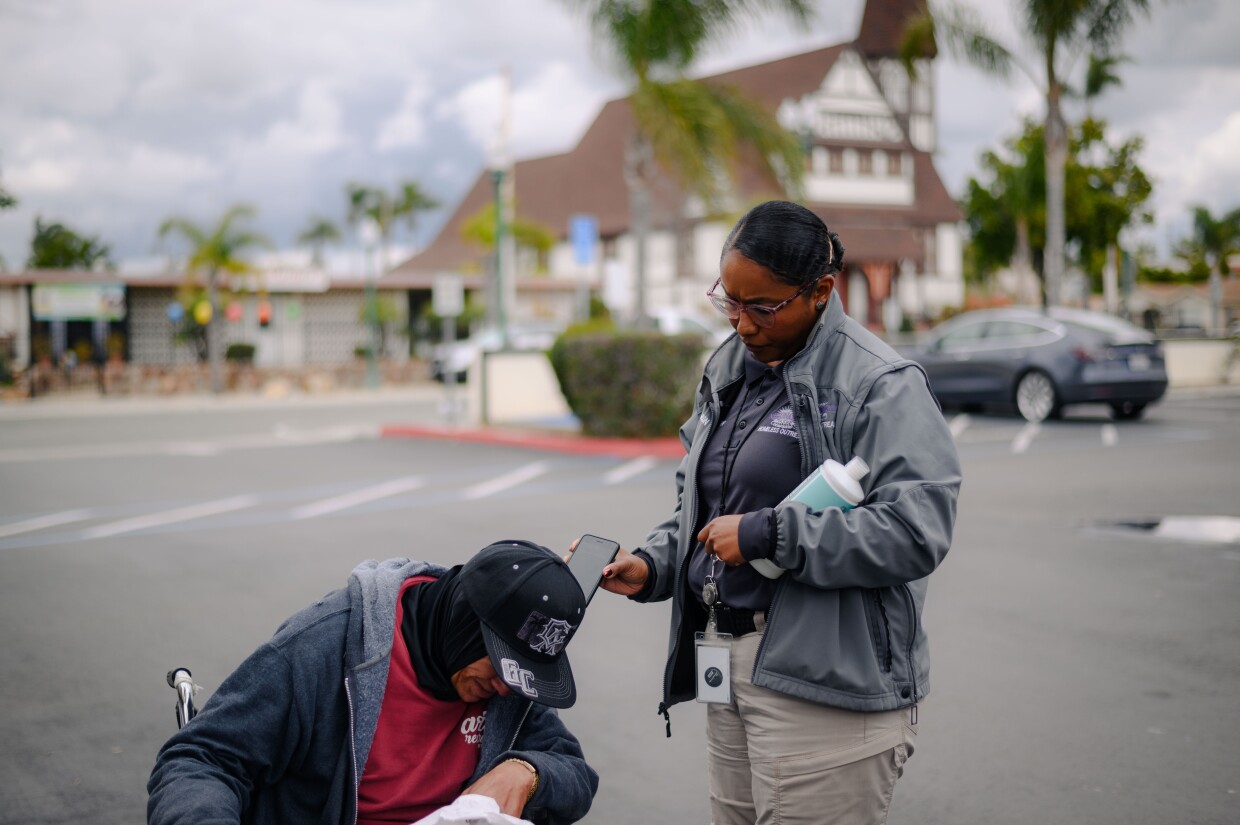

As Williamson and Hueso drove away, the mood was quieter than before.
“We have to find a loophole a lot of times,” said Hueso. “And it’s not that we’re trying to be sneaky or anything, but it’s the way the system’s set up. We have to try and do our best to get them help.”
The loophole in this case, he said, was getting the resident into the emergency room so he would have somewhere to stay until the Family Health Center called again.
Williamson said that wait time wasn’t surprising.
“That’s the process,” she said. “That’s the way it’s supposed to be. But I’m just saying, I wish it wasn’t like that. I wish it didn’t take so long to help someone that’s in need.”






